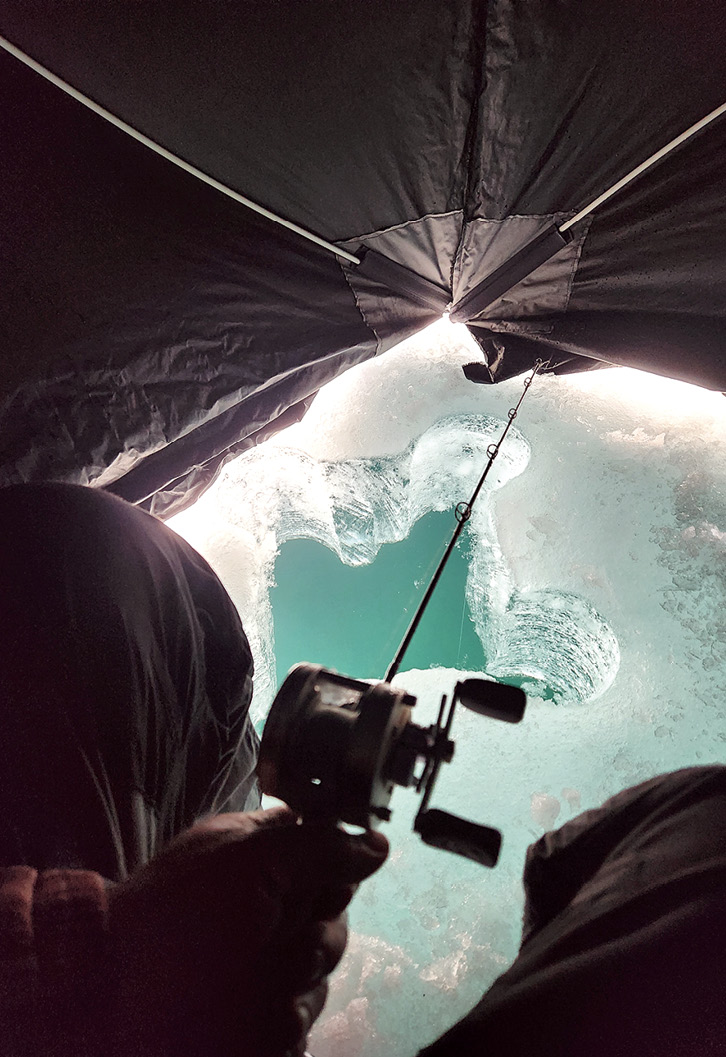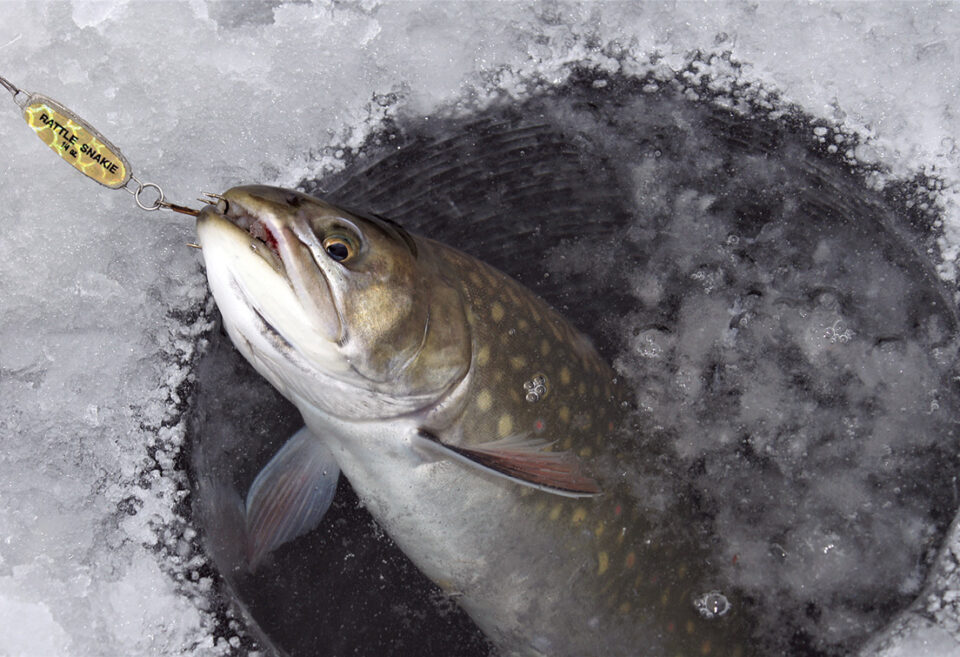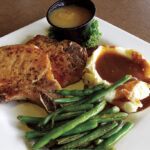The silver Williams Whitefish spoon danced as I lifted it, then dropped it back towards the bottom. The water was crystal clear, and I could easily see to the lake floor in 10 feet of water. As the spoon fluttered off the bottom, a trout appeared and took a swipe at it, but missed. It was a brookie and my heart did a little skip. About a minute passed and I suspected it was gone. Then, as brook trout sometimes do, it roared back in and inhaled the spoon. Line peeled off the reel as the trout bolted off. I dropped the rod tip towards the hole and made sure that as little line as possible was contacting the ice. This was a solid brook trout, dark and thick, but a little less colourful than it would have been in the fall. After a couple of quick pictures, the 23-inch trout was allowed to slip back down the hole and resume its life.
There are few feelings more satisfying than icing a big brookie in the winter. Yet making it happen is rarely easy. Here is a guide to breaking down the winter brook trout game.
Where Do They Live?
Brook trout are a fish that like shoreline. This is true during all four seasons of the year, but it’s especially the case when ice covers lakes, reservoirs, and ponds. The reason brookies dig the ice-covered lake edges is simple: this is where food is found. Those blown down trees, abandoned beaver houses, Labrador tea (a type of shore plant), and boulders that make up shoreline areas provide cover for the things brook trout eat. That list of edibles includes minnows, all manner of nymphs and aquatic insects, leeches, snails, and amphibians. So that means brook trout will cruise the shores of a lake, hoping to intersect with some food—any food. Not all shores are equal however, and there are a few things to look for when you are fishing a new lake.
Shoreline Locations
Visual clues to look for when you are trying to decide where to fish includes points, blown down trees, beaver houses, and inlets or outlets. It’s not always easy to differentiate this stuff in the winter, so looking at Google Earth or any other satellite imagery mapping is worth a try. A low, swampy area in an otherwise steep-edged lake usually marks a creek or seepage.

A few years back, my father Gord Sr. and I were on a stocked spec lake and were getting shut out. We decided to take a snowmobile ride around the edge of the lake and came across what looked to be an inlet. Sure enough, when we got off the sled it was a bit slushier on the ice, a common sign of upwellings. I popped a few holes in and around the mouth of the inlet, some of which were too shallow to fish. However, when we found some water that was 4-5 feet deep, we set up camp. As I prepped a baited still line, Gord Sr. worked another hole with a fire tiger Jigging Rapala. After a few minutes, I heard some drag slipping and looked over to see my dad fighting a nice brookie. I scrambled over just as he dry-docked a beautiful 20-inch trout.
“That’s what we were looking for,” he said, hoisting the crimson flanked fish. We only caught four brook trout in that spot, but they were all beauties. Not one of them was in water deeper than 5 feet.
Another key location for winter brook trout is off of main lake points. A point is a gathering place for bait fish and therefore attracts predators as well. I will take time to cast as much water around a point as possible. Digging holes in shallower water, as well as on the drop offs, means you can try different depths. Put a set line on the shallow spot and jig in deeper water, moving holes every five minutes or so. Winter brook trout will usually take a crack at a lure or bait relatively quickly, which is why I am a big fan of trying as many holes and depths as you can.
Winter Brook Trout Techniques
There are several techniques I rely on to catch winter brookies. One go-to is jigging a lure that throws off a lot of pulse, flash, and movement. Spoons like the Hopkins Smoothie, Northland Buckshot, Williams Whitefish or Little Cleo fit the bill. Spoons have an undeniable trout attracting power and can trigger fish to hit even if nothing else is working. The weight of a spoon can vary from ¼-ounce to ½-ounce. Depending on how deep the water is, a slightly more subtle jigging option is a bucktail or marabou jig fly, with or without bait on it. A jig fly with red, orange, or yellow deer hair or marabou is also a good bet.
My favourite shallow water lure in the winter is a Jigging Shad Rap or Jigging Rapala. These lures spin, glide, and jiggle in all the right ways. They also come in a wide variety of natural and flashy colours. It is hard to go wrong with silver or perch, although fire tiger is a go to. Brook trout have a hard time saying no to biting them. Add a little worm or minnow head to the centre treble as sweetener. There will be no nibbles.
In places where you can use live bait for catching brook trout through the ice, it is always worth trying. I’ve caught some dandy fish on live minnows over the years, primarily on a set line.
Brook trout are active all winter and some of the nicest fish of the year can be targeted through the ice. Get out this winter and probe the frozen waters for these speckled beauties.





